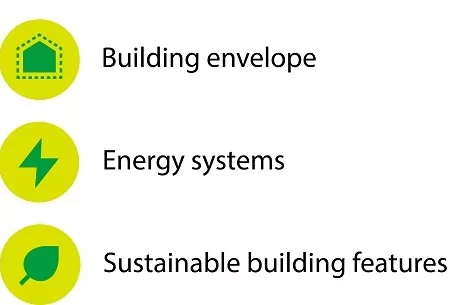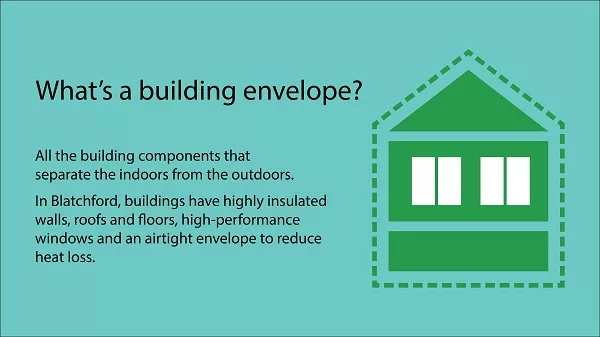Blatchford’s green building codes continue to far exceed standard homebuilder energy performance requirements – even with the updated Alberta edition of the National Building Code effective May 1, 2024.
A townhome designed to Blatchford’s current green building codes is roughly equivalent to a Tier 5 level of energy performance in the 2023 National Building Code (Alberta Edition). That’s about a 70 per cent energy improvement over a building built to Tier 1 – which is the minimum required to meet the energy code and is industry standard.
That’s good news for both the environment and homeowners seeking a more sustainable lifestyle, says the City of Edmonton’s Justin Phill, Senior Engineer, Green Building and Energy Code.
“About 40 per cent of Edmonton’s greenhouse gas emissions comes from buildings. So, having a really good energy efficient building can play an important role in helping to reduce that,” he says.
Building codes – where and how Blatchford’s fit in
The National Building Code sets out technical provisions for the design and construction of new buildings. It also applies to the alteration, change of use and demolition of existing buildings.
The code has five tiers when it comes to energy performance, with Tier 1 being the minimum most often seen in the homebuilding industry.
The City (Blatchford Redevelopment Office) is responsible for developing Blatchford’s land and selling it to homebuilders – in turn, homebuilders are then accountable for building and selling the homes. As the land developer, the City created its own set of green building codes for homebuilders to follow that go above and beyond what the industry requires. To be a Blatchford builder, a homebuilder must first submit their designs to the City and sign an agreement to meet the community’s codes.
An updated Blatchford green building code is coming into effect this year as well to align with the timing of the new National Building Code. “The intent is that we’re always asking Blatchford builders to meet or exceed what the national codes prescribe or require,” says Phill.
The 3 principles of Blatchford’s green building codes

1. Building envelope
Buildings in Blatchford have highly insulated walls, roofs and floors, high performance windows and an airtight envelope to reduce heat loss. The requirements for the building envelope meet or exceed the prescriptive requirements of the National Energy Code for Buildings and energy efficiency requirements of the National Building Code (Alberta Edition).
“As opposed to the more common pink insulation, in Blatchford you’re more likely to see rigid insulation like Styrofoam on the outside – and a builder might also do a double wall with twice as much insulation in it. This really helps with heat loss. I was doing home inspections in the middle of winter and the homes were super comfortable. Not drafty and cold like my 1950s bungalow can be,” says Phill.
He adds one of the reasons you’ll see many cube-like home designs in Blatchford is because this shape leaves fewer spots for heat to leak out. It’s also why you’ll notice a lot of townhouses in the community with shared walls rather than single detached homes, and why there’ll soon be some much-anticipated multi-storey buildings popping up: “A building is more energy efficient per person when it’s more population dense and has less outside walls,” says Phill.

2. Energy systems
The energy systems in Blatchford buildings actively recapture any waste heat and efficiently consume energy through heat recovery ventilators, sealed ductwork and variable speed pumps.
Homeowners are also able to minimize their energy use with advanced heating controls.
“Heat pumps are the most efficient heating and cooling option on the market – and they come already-installed in Blatchford homes that are connected to the District Energy Sharing System,” says Phill. “Heat pumps have a 300 to 400 per cent efficiency rating in electrical use for thermal energy production. Compare that to a typical natural gas furnace, which has less than 100 per cent efficiency.”
3. Sustainable building features
Homebuilder construction practices in Blatchford are intended to reduce the waste materials and air pollutants that can remain in finished buildings. The buildings themselves feature water-efficient fixtures, water and energy efficient appliances and air filtration systems. Renewable energy technology installed for each building – think solar panels – generates clean power for the building to use.
“Being connected to the District Energy System helps you reduce the energy consumption for your heating and cooling. When you add in solar panels – which have been a requirement of Blatchford’s building codes for the past couple of years – you’re then taking sustainable living even further,” says Phill.
Learn more
- Read more about Blatchford’s green building approach and the homeowner benefits of living in Blatchford when it comes to energy conservation.
- Subscribe to our community newsletter.
